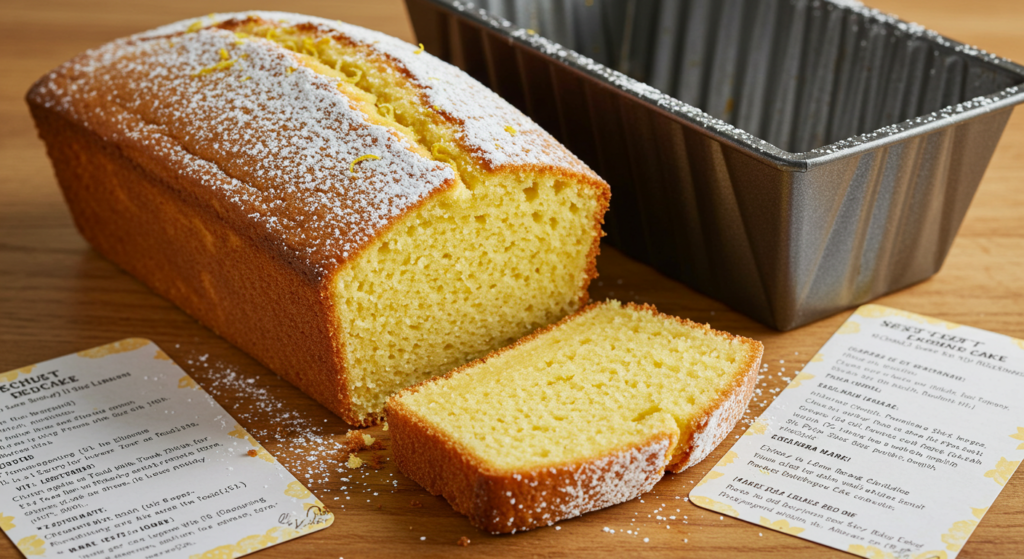Table of Contents
The BEST Lemon Pound Cake
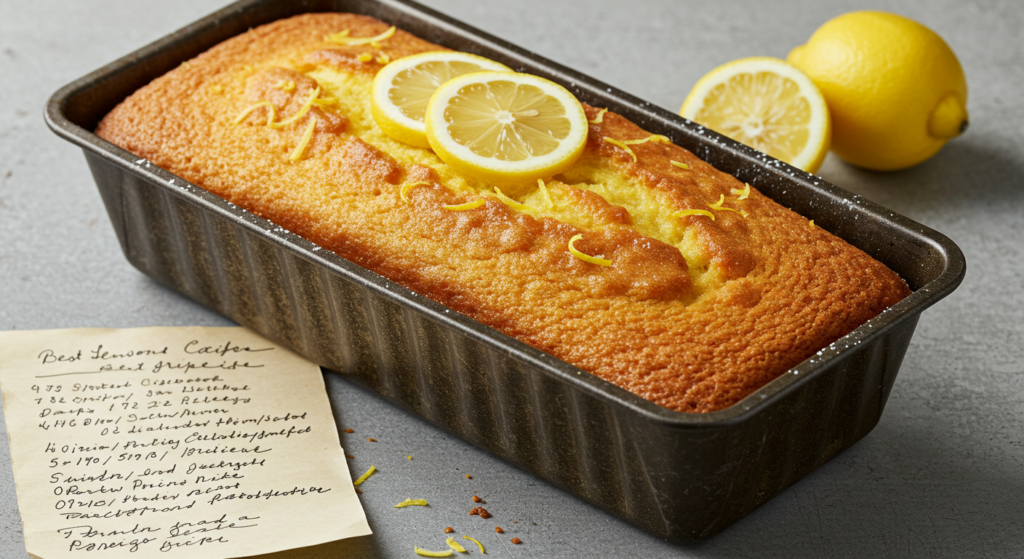
Get ready to discover the ultimate lemon pound cake. It will change your baking game. This citrus dessert is a journey of sweet and tangy flavors. It’s perfect for any occasion, whether you’re an expert or just starting out.
Imagine a moist, buttery cake with bright lemon zest. Add a delicate glaze, and your taste buds will sing. This lemon pound cake is simple yet extraordinary, making it a classic dessert like no other.
Key Takeaways Lemon Pound Cake
- Discover an irresistible lemon pound cake recipe
- Learn the secrets to a perfectly moist citrus dessert
- Master the balance of sweet and tart flavors
- Impress family and friends with professional-level baking skills
- Create a versatile dessert for any occasion
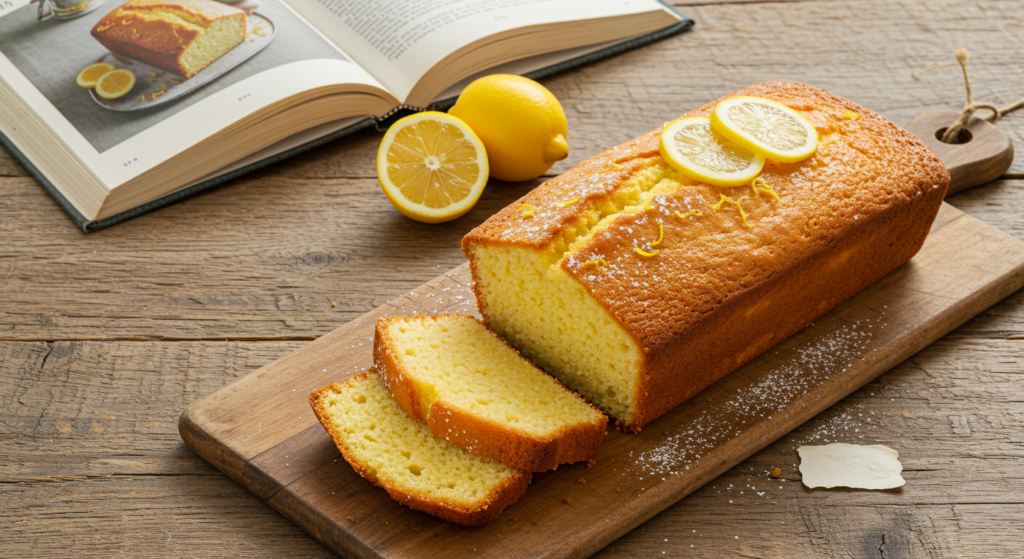
What Makes This Lemon Pound Cake So Special
Explore the world of a truly exceptional classic lemon pound cake. It will change how you bake. This cake is not just another lemon dessert. It’s a masterpiece that blends old techniques with new baking skills.
Making the perfect lemon pound cake is more than just a recipe. It’s about finding the right balance of flavors, textures, and techniques. These elements turn a simple dessert into something truly special.
The Perfect Balance of Sweet and Tart Lemon Pound Cake
This recipe’s magic is in its flavor. It perfectly mixes sweet and tart, creating a taste that’s irresistible. The secret? Choosing the right ingredients and measuring them just right.
- Fresh lemon zest for intense citrus flavor
- High-quality butter for rich, creamy texture
- Perfectly balanced sugar content
Traditional Ingredients with a Modern Twist
This recipe honors classic pound cake traditions but also brings new techniques. It combines old baking methods with new ingredients. This makes the dessert both comforting and exciting.
Why This Recipe Lemon Pound Cake Stands Out
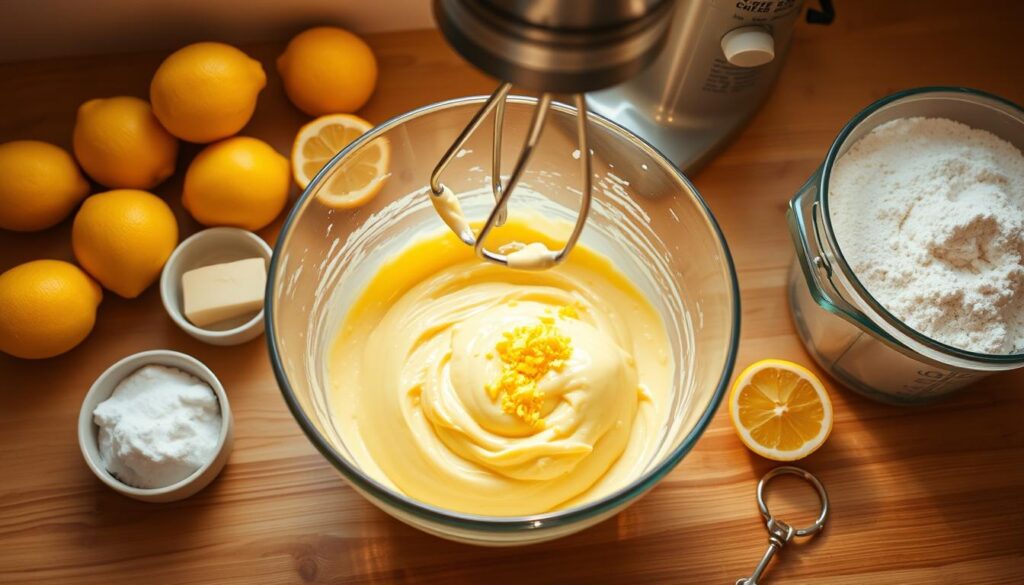
This classic lemon pound cake is special because it’s reliable and always delicious. It’s perfect for both new and experienced bakers. The recipe is precise and easy to follow.
A slice of pure culinary perfection that transforms ordinary moments into memorable experiences.
Every bite is moist and tender, with a burst of lemon flavor. It will excite your taste buds and make you want more.
Essential Ingredients for a Perfect Lemon Pound Cake
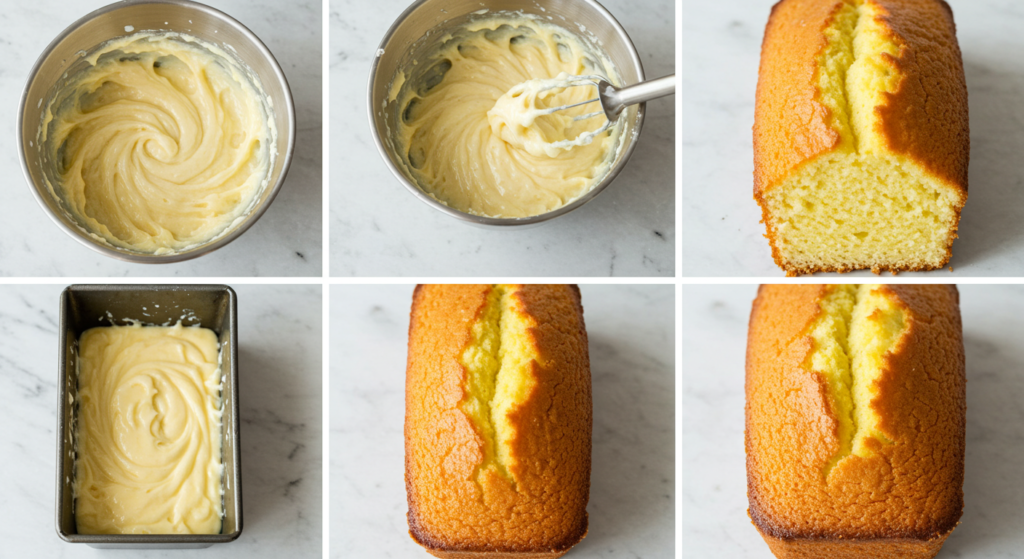
Making a delicious lemon cake begins with the right ingredients. Your cake’s foundation needs top-quality parts to turn simple items into a standout dessert. Let’s look at the key elements that make this lemon pound cake special.
The heart of a great lemon cake is fresh, premium ingredients. You’ll need:
- Unsalted butter (room temperature)
- Fresh lemons (for zest and juice)
- All-purpose flour
- Granulated sugar
- Large eggs
- Vanilla extract
- Baking powder
- Salt
Every ingredient is vital for the perfect lemon pound cake. The butter should be soft and creamy for easy mixing. Fresh lemons are essential – they give that bright, tangy taste that makes a lemon cake stand out.
“The secret to an amazing lemon cake is using real, fresh ingredients and taking time to prepare them properly.” – Professional Pastry Chef
Choose high-quality butter for a rich, creamy texture. This makes your cake luxurious and irresistible. Using full-fat dairy products ensures the most decadent taste.
Pro tip: Make sure all ingredients are at room temperature before mixing. This creates a smooth batter and ensures your cake bakes evenly.
Kitchen Tools and Equipment You’ll Need
Making a delicious pound cake is more than just using great ingredients. The right kitchen tools can make a big difference. This guide will help you get everything you need to make the perfect lemon pound cake.
Must-Have Baking Tools
These tools are essential for making a successful pound cake:
- 9×5 inch Loaf Pan – The classic size for traditional pound cakes
- Electric Mixer (Stand or Hand Mixer) – Critical for creating a smooth, well-incorporated batter
- Large Mixing Bowls – Preferably ceramic or stainless steel
- Rubber Spatula – For scraping down bowl sides and ensuring even mixing
- Cooling Rack – Prevents soggy cake bottoms
Optional but Helpful Equipment
These tools can make your baking experience better:
- Parchment Paper – Helps prevent sticking and ensures easy cake removal
- Kitchen Scale – For precise ingredient measurements
- Zester or Microplane – Perfect for extracting lemon zest
- Offset Spatula – Helps create smooth glaze and cake top
Measuring and Mixing Essentials
Accurate measurements are key for a moist pound cake. Get quality measuring tools:
- Dry Measuring Cups
- Liquid Measuring Cups
- Measuring Spoons
- Instant-Read Thermometer – Helps check cake doneness
With these tools, you’ll be ready to make a professional-quality lemon pound cake. It’s sure to impress!
Step-by-Step Mixing and Baking Process

Making the perfect lemon pound cake needs precision and care. Start by getting all your ingredients ready and your workspace clean. Make sure everything is at room temperature for smooth mixing and the best texture.
Here are the key steps to make a delicious lemon loaf that will wow your family and friends:
- Prepare your baking pan by greasing it well and dusting with flour
- Cream butter and sugar until light and fluffy – this step is crucial for a tender lemon pound cake
- Add eggs one at a time, mixing completely between each addition
- Incorporate lemon zest and juice to enhance the cake’s bright flavor
- Gently fold in dry ingredients, being careful not to overmix
When mixing your lemon pound cake batter, technique matters more than speed. Use a stand mixer or hand mixer on medium speed for even mixing. Look for a smooth, silky consistency to know your ingredients are perfectly mixed.
Baking needs patience and attention. Preheat your oven to 325°F and put the lemon loaf in the center rack. Bake for about 60-75 minutes, checking with a toothpick inserted into the center. The cake should be clean and golden brown.
Pro tip: Let your lemon pound cake cool in the pan for 10-15 minutes before transferring to a wire rack. This helps keep moisture and prevents crumbling.
Creating the Perfect Lemon Glaze
A lemon glaze can turn a simple pound cake into a stunning citrus dessert. The right glaze adds a bright, tangy finish that complements the cake’s richness.
The secret to a great lemon glaze is balance and technique. You aim for a smooth, shiny coating that boosts the cake’s flavor without overpowering it.
Glaze Consistency Mastery
Getting the perfect lemon glaze needs precision. You want a consistency that’s:
- Smooth and pourable
- Thick enough to coat the cake
- Thin enough to drizzle elegantly
Professional Application Techniques
Here are some pro tips for applying your lemon glaze:
- Let the cake cool completely before glazing
- Use a wire rack to catch excess glaze
- Drizzle in a zigzag pattern for visual appeal
Temperature and Timing Insights
Temperature is key for your citrus dessert’s look. A glaze that’s too warm will run off, while one that’s too cool won’t spread well. Aim for a room temperature glaze, around 70°F, for the best results.
Pro tip: If your glaze is too thick, add a teaspoon of milk. If it’s too thin, add more powdered sugar.
Tips for Achieving a Moist and Buttery Texture

To make a buttery cake with the right moist texture, you need to be precise and use expert techniques. The secret to a delicious lemon pound cake is knowing how ingredients and baking methods work together.
First, make sure all ingredients are at room temperature. Cold ingredients can lead to uneven mixing and affect the cake’s texture. The butter should be soft but not too runny, making it easy to mix into the batter.
- Use full-fat dairy products like sour cream or Greek yogurt to enhance moisture
- Measure ingredients precisely using kitchen scales
- Avoid overmixing the batter to prevent tough, dense cake
- Cream butter and sugar thoroughly for a light, tender crumb
The way you mix the ingredients is key to a moist pound cake. Gently fold them together to keep air pockets in. Gentle folding prevents gluten development, which can make your cake tough and dry.
Baking time and temperature are very important for a moist cake. Use an oven thermometer to check the temperature and avoid overbaking. A toothpick inserted near the center should have a few moist crumbs for the perfect texture.
Pro Tip: Let your pound cake cool completely before glazing to lock in moisture and prevent soggy edges.
Common Mistakes to Avoid When Making Lemon Pound Cake
Baking the perfect lemon pound cake needs precision and focus. Even skilled bakers can face challenges. Knowing these common mistakes helps you bake with confidence.
Ingredient Temperature Challenges
Temperature is key for a successful lemon cake. Cold ingredients can ruin your cake, making it dense. Make sure your butter, eggs, and milk are at room temperature before you start.
- Let butter soften for 30-45 minutes before mixing
- Remove eggs from refrigerator 1 hour prior to baking
- Use room temperature milk or buttermilk
Mixing Method Mishaps
How you mix the batter affects the cake’s texture. Overmixing can make the cake tough. Undermixing leaves unmixed ingredients.
- Cream butter and sugar until light and fluffy
- Add eggs one at a time, mixing thoroughly
- Fold dry ingredients gently until just combined
Baking Time Troubles
Getting the baking time right is crucial. Oven temperatures vary, so timing is key. Use these tips for the best results.
- Preheat oven completely before inserting cake
- Use an accurate oven thermometer
- Check doneness with a toothpick test
- Rotate pan midway through baking for even heat distribution
Pro tip: Every oven is unique, so getting to know yours is key to baking the perfect pound cake recipe.
Storage and Serving Suggestions
Keeping your homemade lemon pound cake fresh is key. Whether it’s a new loaf or leftovers, knowing how to store it is important.
For best results, store your cake at room temperature. Use an airtight container or wrap it well with plastic wrap. This way, your lemon loaf stays moist and tasty for 3-4 days.
- For short-term storage, use a cake dome or container with a tight-fitting lid
- Avoid storing near heat sources or direct sunlight
- Keep the cake away from strong-smelling foods
Refrigeration helps your cake last longer. Wrap it in plastic wrap or foil to prevent drying. Before serving, let it sit at room temperature for 30 minutes to regain its softness.
Freezing is great for longer storage. Wrap slices or the whole loaf in plastic wrap, then in a freezer-safe bag. Frozen lemon pound cake can last 2-3 months.
- Thaw frozen cake in the refrigerator overnight
- Bring to room temperature before serving
- Optional: Refresh with a light dusting of powdered sugar
Here are some elegant ways to serve your lemon pound cake:
- Garnish with fresh lemon zest
- Add a dollop of whipped cream
- Pair with a cup of hot tea or coffee
Pro tip: A warm slice of lemon pound cake pairs perfectly with a scoop of vanilla ice cream for an indulgent dessert experience.
Conclusion
Making the perfect classic lemon pound cake is more than just a recipe. It’s about creating a special culinary experience. You’ve learned expert techniques and tips to bake a dessert that will wow everyone.
You now know how to mix simple ingredients into an amazing treat. You can make a moist, tender crumb and a bright lemon flavor. Your homemade cake will show off your baking skills and brighten any table.
Baking is an art that needs passion and practice. Every time you bake this recipe, you’ll get better and understand flavors more. We encourage you to try new things, make this recipe your own, and share your successes with others. Your baking journey is just starting!
Enjoy the joy of baking and let this lemon pound cake become a favorite in your kitchen. Happy baking!
FAQ
How long does this lemon pound cake stay fresh?
Your lemon pound cake stays fresh for 3-4 days at room temperature. If you refrigerate it, it lasts 5-7 days. You can freeze it for 2-3 months. Just wrap it tightly in plastic and foil.
Can I make this recipe gluten-free?
Yes, you can! Use a gluten-free flour blend with xanthan gum. Find a cup-for-cup replacement for the right texture. Make sure all ingredients are gluten-free for those with sensitivities.
What type of lemons work best for this pound cake?
Meyer lemons are great because they’re sweeter. But Eureka or Lisbon lemons work well too. Use fresh lemons for the best flavor, including zest and juice.
How can I tell if my pound cake is fully baked?
Check with the toothpick test. If it comes out clean, it’s done. The top should be golden and springy. It usually takes 60-75 minutes at 350°F.
Can I make this cake without a stand mixer?
Yes, you can use a hand mixer or whisk and spoon. Cream the butter and sugar well. Be careful not to overmix when adding other ingredients.
How do I prevent my lemon pound cake from becoming dry?
To keep it moist, don’t overmix and use room temperature ingredients. Measure flour correctly and don’t overbake. Sour cream or Greek yogurt can help. The lemon glaze also keeps it soft.
Can I add other flavors to this lemon pound cake?
Certainly! Try blueberries, poppy seeds, or lavender. For a twist, add fresh thyme or rosemary. But don’t add too much to keep the texture right.
Is it possible to make this cake ahead of time?
Yes, it’s perfect for making ahead. Bake 1-2 days before and store at room temperature. The flavors get better over time. Add the glaze just before serving for the best taste and look.
The BEST Lemon Pound Cake
Description
Cheesy Vegan Pizza Beans is a delicious and satisfying vegan dish that is perfect for a quick dinner or a satisfying snack. Made with kidney beans, tomato sauce, and vegan cheese, this dish is packed with protein and flavor.
Ingredients
Nutrition Facts
Servings 1
- Amount Per Serving
- Calories 386kcal
- % Daily Value *
- Total Fat 16.7g26%
- Saturated Fat 2.4g12%
- Total Carbohydrate 56.5g19%
- Sugars 7.5g
- Protein 18.2g37%
- Vitamin A 302 IU
- Vitamin C 12 mg
- Calcium 135 mg
- Iron 7 mg
* Percent Daily Values are based on a 2,000 calorie diet. Your daily value may be higher or lower depending on your calorie needs.
Note
You can also use other types of beans in this recipe, such as black beans or pinto beans.
Feel free to get creative and add your favorite pizza toppings to the mix!

